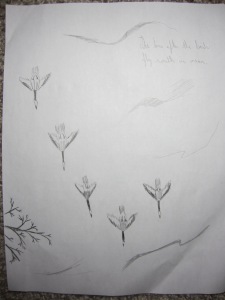CB6: Friluftsliv and Interdisciplinary Planning
My Creative Journal consisted of me jotting down notes and thoughts about stuff we did in class the past couple weeks. I enjoyed the article Friluftsliv: The Scandinavian Philosophy of Outdoor Life by Hans Gelter (2000). Friluftsliv, or “free air life”, as a philosophy makes sense. Nature is appreciated for nature’s sake; not as a commodity, or something utilitarian, or a conquest. It teaches us to avoid tokenism in outdoor education. My one reservation about Gelter’s article is he uses countryside nature in his examples because he comes from a place where it is in abundance. I would argue Friluftsliv can occur in your local park.
I also wrote about an old German proverb that shot into my head after reading the luft in friluftsliv. The saying is Stadtluft macht frei which translates to city air makes you free. The philosophy behind this statement is the vibrancy of a city creates a certain intellectual freedom and exchange of ideas between people. I wonder too if there is a more literal sense to the saying going back to the time of free cities and vassalage. Both ideas just sort of represent the different sides of humanity, the social part that drives us to urbanization and our great cities, yet there is a part of us that looks back to nature to combat the perceived corruption that is inevitable with over-urbanization. Both are necessary to feed the mind and soul.
I also reflected on the outdoor activities we did as a class. My group chose to do the 5 minute demonstration in which we were trying to save bees. Ten years ago, I might have felt foolish parading about; now, I don’t care. You’re in someone’s mind for a second and then out of it. Any embarrassment is one’s own projections. Also, as teachers, if you are afraid to look foolish, you might be in the wrong profession. The exercise made me think more about how you raise awareness of environmental issues. How many people really pay attention to that a kind of demonstration or do they dismiss it, as I do, as just noise? As future educators, I think we may have the best forum at our disposal to inform the public regarding environmental issues.
Finally, I jotted my ideas about interdisciplinary planning and thought back to the article by David Orr (2004) What is Education For? and about the line “All education is environmental education”. I think we all demonstrated with our unit plans how different issues are applicable within other subjects. While some subjects are more explicitly related to the environment, every thing we do in education is ultimately aimed at understanding our environment from mathematical models to philosophy. Essentially there is just one huge outcome and a plethora of indicators.
References
Gelter H., (2000). Friluftsliv: The Scandinavian Philosophy of Outdoor Life. Canadian Journal of Environmental Education. 5(1), 77-90.
Orr, David. (2004). What is Education For? In Earth in Mind, p. 7-15. Washignton DC: First Island Press.

